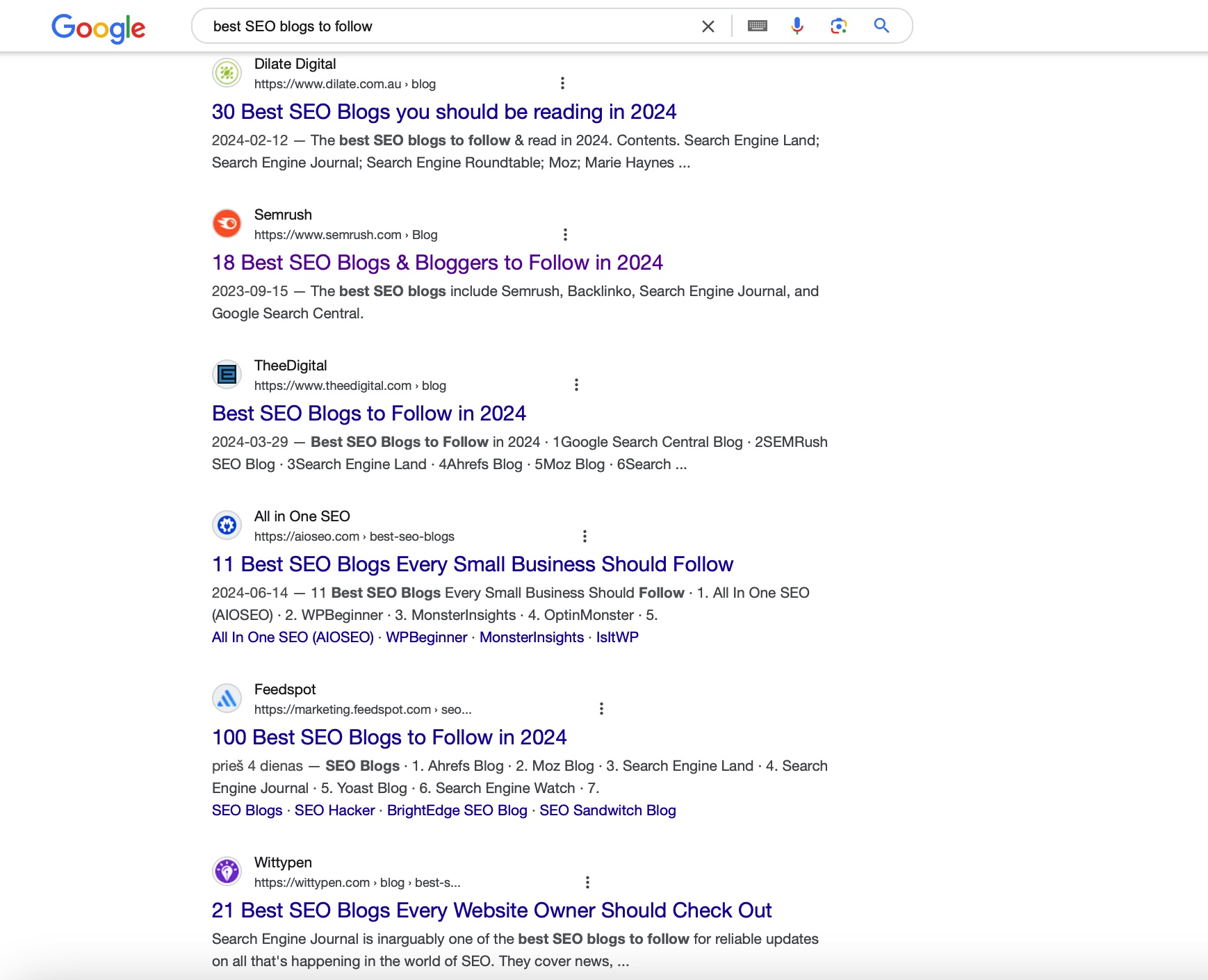
SEO Tips to Consider for SEO-Friendly Blog Posts
Having a fancy-looking website and providing quality products and services is not enough to be successful online, it's also important to have a strong position and demonstrate your extensive knowledge in the industry in which you operate. An SEO-friendly content in a blog post format is one of the best tools to achieve that. Search engines like Google prioritize content that not only resonates with user queries but also provides valuable and authoritative information. In this blog post, we’ll go over 10 key strategies to help you create blog posts that rank well and drive traffic. Let’s dive into the steps you can take to optimize blog for search engines while providing value to your audience.
1. Target keywords and topics with traffic potential
The foundation of any SEO strategy begins with keyword research. So does the blog SEO - by identifying the keywords and topics that have substantial search volume and traffic potential, you can create content that meets the needs of your target audience.
Focus on finding keywords that balance search volume with competition. Find the “correct” keyword phrases and forms as well as similar words to enrich your content. Long-tail keywords can be particularly useful as they often capture more specific user intent and may have lower competition, making it easier for your blog post to rank higher.
If you are not sure what to write next, you can use available resources to analyze what topics and keywords are trending. SEO tools like Google Trends, Google Keyword Planner, Ahrefs or SEMrush can help you uncover these search trends. Once you've identified relevant keywords and themes – start writing and integrate these keywords and topics into your Blog post.
2. Match your content with search intent
Search intent refers to the reason behind a user’s query. Is the user looking for information, a product, or a solution to a problem? Creating content that aligns with this intent is crucial for SEO success. Analyze the top-ranking pages for your target keywords to understand what type of content is currently performing well. This will guide you in tailoring your blog post to meet user expectations, whether it's an in-depth guide, a list, or a product review.
If you want to rank higher on Google, you’ll need to match search intent. To identify the intent you‘ll need to analyze the top-ranking pages in SERPs for your target keyword. You want to check:
- Content type – find the most common content type for your topic.
- Content format – find the most common content format for your topic.
- Content angle - what unites the most highly-ranked content? Is there a common objective, such as targeting beginners, or is there focus on fresh content?
Let take an example. We want to write a post on “best SEO blogs to follow”. If we type it in Google, the search results are shown as following:

For this topic we find:
- Content type – blog posts.
- Content format – lists.
- Content angle – more general, focusing on fresh information (2024).
Having this information we can see that the best way to rank in “best SEO blogs to follow” topic is to create a blog post with a list of blogs aimed at different levels of experience and expertise, such as sections dedicated for beginners, mid-level and experts. The title should also include the year to show the relevance of the content.
3. Use your experience and expertise
Google values helpful content that demonstrates experience, expertise, authority, and trustworthiness (E-E-A-T):
- Experience – personal life experience in the topic.
- Expertise – expert level knowledge or skill in a field.
- Authoritativeness – reputation among others in the industry.
- Trust – most important EEAT signal; security, legitimacy, transparency, and accuracy of the website and its content.
Using your personal experience and industry expertise within your blog not only makes your content more credible but also more valuable to readers. Share case studies, examples, and insights that only you or your business can provide. This not only strengthens your content but also differentiates it from competitors. And if you lack it, hire someone with experience and expertise to write it for you.
4. Create valuable blog content worth sharing
The most successful blog posts offer readers something of real value. Whether it’s actionable advice, fresh perspectives, or detailed solutions, your content should be worth sharing. This not only boosts your blog’s visibility but also increases its authority through backlinks. When people find your content useful and relevant, they are more likely to share it on social media, link to it from their own blogs, and recommend it to others.
Some ideas to get started:
- Interview experts – get expert level content in your blog post by interviewing the industry experts;
- Use your personal experience – write a case study that you conducted yourself, write about products and services that you actually tried and can explain step-by-step how to use it.
- Conduct your own research – writing content that is backed with statistical data shows that your company is forward-thinking because you're setting trends and data for your industry.
- Use different angle or alternative approach – something like “Why you shouldn’t follow SEO blogs”; or maybe is worth trying to be the first and write a blog post capturing “I followed 10 best SEO blogs here are the results”.
5. Easy-to-read structure with paragraphs and headings
An organized, easy-to-read structure is essential for both users and search engines. You should follow a simple content structure for your post:
- An introduction, where you introduce your topic and explain why it is in the spotlight;
- A body, where all main information is written;
- A conclusion, where you draw conclusions and sum up main points of the post.
Break your content into smaller paragraphs, shorter sentences, use headers (H1) and subheaders (H2, H3,..), and incorporate bullet points or numbered lists where applicable. Proper headings help your readers understand what specific part of your text is about and makes your blog post scannable and digestible by Search engines, that also use these structural elements to better understand the hierarchy of your content.
6. Add links to existing content
Internal linking is a simple yet powerful search engine optimization strategy. By linking to relevant existing content on your website, you help search engines crawl and index your site more effectively, while also guiding readers to explore more of your material. This can reduce bounce rates, improve engagement and increase the average session duration on your site.
What to link: your other blog post talking about certain matter in more depth; your landing pages for products and services, call-to-action forms, contacts, etc. Another best practice is to also use external links to authoritative sources that can also boost the credibility of your content, showing that you’ve done your research and your data is reliable.
7. Optimize and create inviting blog post titles
Your blog title is the first thing users see, and it plays a significant role in SEO efforts. It should be both inviting and keyword-optimized. A well-crafted title not only attracts clicks but also gives search engines context about the content of your blog post.
Keep your title concise, around 60 characters, and make sure it clearly reflects the topic of your blog post. Engaging titles that evoke curiosity or promise value can also improve click-through rates. It should also reflect the competition and be based on the research such as we’ve quickly have made in the beginning by looking at the SERPs and investigating the search intent for “best SEO blogs to follow”.
8. Use SEO friendly URLs
Keep the URL of your blog post short, descriptive, and keyword-rich. Avoid long, complicated URLs with unnecessary parameters or numbers. Instead, use clean URLs that reflect the main topic of your post. For example, a post about SEO blogs might use the URL: “/best-seo-blogs-to-follow.” This helps search engines and users understand the content at a glance.
You can skip adding the year to the URL if you are willing to update your content and repurpose it through the years. For example, if you write a good article in 2024 that is well-rated in search and gain valuable backlinks, in the following 2025 year you can update the Title and the content to reflect the “freshness” of the content but keep the gained value of the backlinks and keep yourself in the top-ranking positions.
9. Publish content regularly
Consistency is key to building and maintaining SEO success, ratings and Google interest your content. Publishing blog posts on a regular schedule signals to search engines that your website is active and regularly updated, which can attract Googlebot to crawl your page more often and positively affect your rankings.
Extensive websites or websites with lower or fixed number of product or services, both could definitely benefit from writing a blog section to show further expertise and build trust. Regular content updates also keep your audience engaged and coming back for more, fostering loyalty and increasing traffic over.
10. Keep your content up-to-date
SEO isn't a set-it-and-forget-it strategy. Updating old content with new data, insights, and improvements is essential for maintaining relevance. Google favors fresh content, so revisiting your blog posts periodically to ensure they are still accurate and up-to-date can help preserve their rankings. This also demonstrates to readers that your blog is a reliable and current source of information.
You can also repurpose the old blog, and from old material create fresh - for example turn three old posts into one new. Or, if you are guaranteed the content is no longer usable and relevant, you can delete it. In all scenarios, where you getting rid of the old URLs, don’t forget to make proper redirects to new pages with proper codes (such as 301).
Conclusion
Creating an SEO-friendly blog post requires a balanced combination of technical optimization and valuable content creation. By following these 10 key tips - targeting high-traffic keywords, aligning with search intent, and regularly updating your content - you can enhance your blog’s visibility, engage your audience, and improve your search engine rankings. SEO is an ongoing process, but with consistent effort, your blog will steadily climb the ranks and attract the traffic it deserves. Keep refining your strategy, and watch your blog’s success grow! And if you need some inspiration and more SEO tips - follow our blog.



